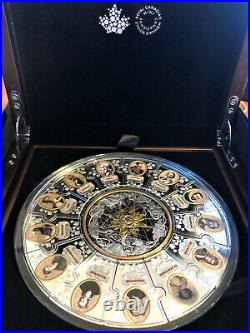
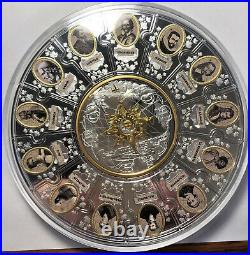
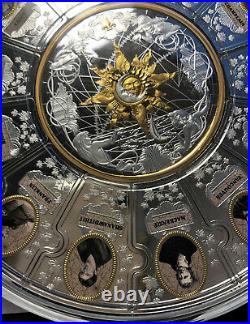
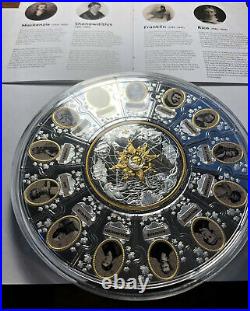
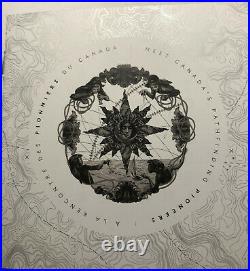
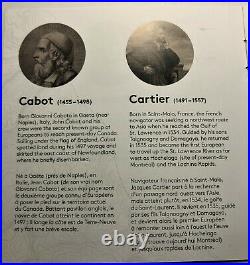
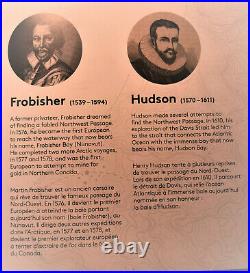
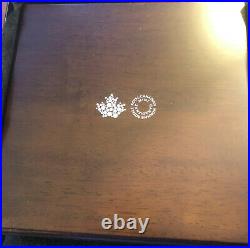
The Four Winds: Pathfinders in Canada – Lovely 2020 Pure Silver Proof Puzzle Coin Set From the. Pathfinders is Third Puzzle Coin in the Series. In 2017 the Royal Canadian Mint issued its first new puzzle coin. The Canada 150 – Mintage: 800. This coin documents when each province and territory joined Confederation. Was issued with a mintage of only 800 coins. There was no puzzle coin issued in 2019. However collectors were eagerly waiting for the next coin in the series and it was finally issued in 2020 and it continues the Canadian story and chronicles nearly 1000 years of exploration. You can study Canadas great Pathfinders as you immerse yourself in Canadian history. Now is your chance to add this elusive low mintage coin set to your own collection. Guided by the Four Winds and a gorgeous compass rose, this 14-piece puzzle coin set takes you on a course through Canada’s adventure-filled past. Each of the 13 puzzle-shaped coins highlights a famous pathfinder in Canadian history who contributed to our understanding of the world and our place in it. Together, they span nearly 1,000 years of history that is preserved in written accounts and illustrations, which pull the past forward and make it accessible today. Your coin is a map-inspired celebration of our inquisitive spirit and our Pathfinding Pioneers. BACK BY POPULAR DEMAND! Pieces of Canada’s past come together in this puzzle coin set, which celebrates famous pathfinders, cartographers and chroniclers of Canadian history. DEDICATED TO THOSE WHO PRESERVE HISTORY. The central coin at the heart of this puzzle celebrates history’s mapmakers. With its personification of the Four Winds, the cartography-themed design evokes the thrill of adventure! STORYTELLING AT ITS FINEST. Nearly 1,000 years of Canadian history are represented on the 13 puzzle-shaped coins. It’s a veritable photo album that begins with Canada’s Viking Age and ends with a 20th century trailblazer. In addition to the “gilded” frames on each puzzle coin, the centre coin features selective gold plating on the compass rose and its rim, as well as the effigy on the obverse. Each puzzle coin set comes with a special booklet that explains each person’s place on this coin and in Canadian history. It’s a must-have for any history enthusiast! You won’t need to piece this puzzle together it comes packaged as a completed puzzle. Inside the wooden collector case, you’ll find all 14 individually encapsulated coins already positioned in place. You’ll notice a slight space between them this is to draw attention to the individual pieces while also reducing the risk of contact during transit. HERITAGE AND PRESTIGE, COMBINED. Each obverse features the gold-plated effigy of Her Majesty Queen Elizabeth II by Susanna Blunt. I’ve always been drawn to stories on the high seas, especially with benevolent spirits of nature watching over and guiding the adventurers. Greek mythology and high fantasy novels inspire many of my designs, and with the middle coin, I wanted to pay homage to the Age of Exploration and the unique wonder of sighting a new piece of land in the distance. The disappearance of the 1845 Franklin Expedition sparked a series of search-and-rescue expeditions that continued for nearly 170 years. The wreck of HMS Erebus was located by Parks Canada in 2014, and HMS Terror was discovered two years later. Packaging: Your completed puzzle comes beautifully packaged in a wooden collector case with black beauty box. Each coin is individually encapsulated with a defined space between them, to draw attention to the individual pieces and reduce the risk of rubbing during transit. Composition: 99.99% pure silver with selective gold plating. Weight: (g)502.47. Diameter: (mm)123.7. Artist: Rebecca Yanovskayar (reverse), Susanna Blunt (obverse). The 13 Featured Pathfinders in Canadian History. Leif Erikson (970 1020) – The son of Erik the Red is the first known European to have set foot on Canadas shores. Setting sail from Greenland in the year 1000, Leif and his companions likely sighted the shores of Baffin Island (Helluland) and Labrador (Markland) before landing and wintering near LAnse aux Meadows, Newfoundland and Labrador, site of the only authenticated Viking settlement in North America. John Cabot (1455 1498) – Born Giovanni Caboto in Gaeta (near Naples), Italy, John Cabot and his crew were the second known group of Europeans to reach present-day Canada. Sailing under the flag of England, Cabot spotted land during his 1497 voyage and skirted the east coast of Newfoundland, where he briefly disembarked. Jacques Cartier (1491 1557) – Born in Saint-Malo, France, the French navigator was seeking a northwest route to Asia when he reached the Gulf of St. Lawrence River as far west as Hochelaga (site of present-day Montréal) and the Lachine Rapids. Martin Frobisher (1539 1594) – A former privateer, Frobisher dreamed of finding a fabled Northwest Passage. In 1576, he became the first European to reach the waterway that now bears his name, Frobisher Bay (Nunavut). He completed two more Arctic voyages, in 1577 and 1578, and was the first European to attempt to mine for gold in Northern Canada. Henry Hudson (1570 1611) – Hudson made several attempts to find the Northwest Passage. In 1610, his exploration of the Davis Strait led him to the strait that connects the Atlantic Ocean with the immense bay that now bears his name, Hudson Bay. Samuel de Champlain (1574 1635) – The Father of New France was a skilled cartographer who surveyed portions of the Atlantic coastline, the St. Lawrence River and parts of the Great Lakes. His writings and charts laid the foundation for further exploration inland. In 1608, he built the first permanent (and continuous) habitation in New France on the site of present-day city of Québec. René-Robert Cavelier, Sieur de La Salle (1643 1687) – After his arrival in 1667, the former Jesuit set up a fur trade outpost near the Lachine Rapids. He completed several expeditions down the Ohio, Illinois and Mississippi Rivers, where he set up a network of forts and trading posts and claimed huge regions of land for France. Upon reaching the Gulf of Mexico in 1682, he named the region La Louisiane in honour of King Louis XIV. Pierre Gaultier de Varennes, Sieur de La Vérendrye (1685 1749) – Born in Trois-Rivières, La Vérendrye dreamed of finding the western sea that lay beyond the Great Lakes. With the help of Indigenous guides, La Vérendrye and his crew including four sons pushed far west as he explored the lakes and rivers of Manitoba and southern Saskatchewan. He was part of a process that added Western Canada to the original New France territory. George Vancouver (1757 1798) – A talented cartographer, Vancouver was a member of James Cooks expedition to the northwest in 1778, when they became the first known Europeans to set foot on Canadas Pacific shores. Between 1791 and 1795, he charted the west coast from 30 N to 56 N and travelled some 96,200 km in his quest for the Northwest Passage. Alexander Mackenzie (1764 1820) – The Scottish-born fur trader was the first European explorer to reach the Pacific by crossing the continent. Helped by Indigenous guides, Mackenzies first expedition in 1789 led him down the long river that bears his name, the Mackenzie River, until he reached the Arctic Ocean. Shanawdithit (1801 1829) – The last surviving member of the Beothuk Nation in Newfoundland, Shanawdithit was taken by the British in 1823 and learned English while working as a servant. After moving to St. Johns in 1828, she played a key role in preserving Beothuk culture and history through her illustrations and translation work. John Franklin (1786 1847) – Franklin led four Arctic expeditions, including one in 1826 that mapped the coastline west of Coppermine River. Last seen in Baffin Bay in 1845, the disappearance of Franklin, his crew and his two ships, the Erebus and the Terror, became one of the great mysteries of the age of exploration. Kate Rice (1882 1963) – Dubbed Extraordinary Woman of the Wilds, Canadas first prominent female prospector was born in St. The former teacher turned homesteader learned the Cree language and took up prospecting in Northern Manitoba. Her copper and nickel discoveries helped transform Thompson, Manitoba into an important mining hub. The item “2020 THE FOUR WINDS PATHFINDERS IN CANADA SILVER PUZZLE COIN SET MINT SOLD OUT” is in sale since Monday, March 29, 2021. This item is in the category “Coins & Paper Money\Coins\ Canada\Commemorative”. The seller is “raytrott” and is located in Mississauga, Ontario. This item can be shipped to Canada, all countries in Europe, United States.
- Modified Item: No
- Country/Region of Manufacture: Canada
- Certification: Uncertified
- Grade: Ungraded
- Type: Commemorative
- Year: 2020
- Circulated/Uncirculated: Uncirculated
